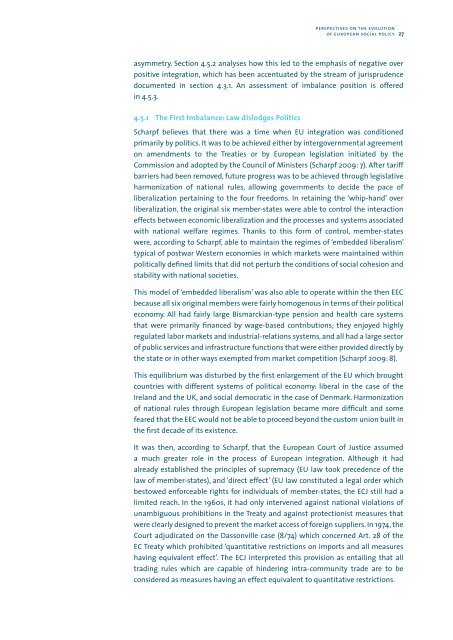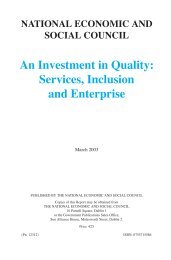4. Perspectives on the Evolution of European Social Policy
4. Perspectives on the Evolution of European Social Policy
4. Perspectives on the Evolution of European Social Policy
- No tags were found...
Create successful ePaper yourself
Turn your PDF publications into a flip-book with our unique Google optimized e-Paper software.
perspectives <strong>on</strong> <strong>the</strong> evoluti<strong>on</strong><strong>of</strong> european social policy 27asymmetry. Secti<strong>on</strong> <str<strong>on</strong>g>4.</str<strong>on</strong>g>5.2 analyses how this led to <strong>the</strong> emphasis <strong>of</strong> negative overpositive integrati<strong>on</strong>, which has been accentuated by <strong>the</strong> stream <strong>of</strong> jurisprudencedocumented in secti<strong>on</strong> <str<strong>on</strong>g>4.</str<strong>on</strong>g>3.1. An assessment <strong>of</strong> imbalance positi<strong>on</strong> is <strong>of</strong>feredin <str<strong>on</strong>g>4.</str<strong>on</strong>g>5.3.<str<strong>on</strong>g>4.</str<strong>on</strong>g>5.1 The First Imbalance: Law dislodges PoliticsScharpf believes that <strong>the</strong>re was a time when EU integrati<strong>on</strong> was c<strong>on</strong>diti<strong>on</strong>edprimarily by politics. It was to be achieved ei<strong>the</strong>r by intergovernmental agreement<strong>on</strong> amendments to <strong>the</strong> Treaties or by <strong>European</strong> legislati<strong>on</strong> initiated by <strong>the</strong>Commissi<strong>on</strong> and adopted by <strong>the</strong> Council <strong>of</strong> Ministers (Scharpf 2009: 7). After tariffbarriers had been removed, future progress was to be achieved through legislativeharm<strong>on</strong>izati<strong>on</strong> <strong>of</strong> nati<strong>on</strong>al rules, allowing governments to decide <strong>the</strong> pace <strong>of</strong>liberalizati<strong>on</strong> pertaining to <strong>the</strong> four freedoms. In retaining <strong>the</strong> ‘whip-hand’ overliberalizati<strong>on</strong>, <strong>the</strong> original six member-states were able to c<strong>on</strong>trol <strong>the</strong> interacti<strong>on</strong>effects between ec<strong>on</strong>omic liberalizati<strong>on</strong> and <strong>the</strong> processes and systems associatedwith nati<strong>on</strong>al welfare regimes. Thanks to this form <strong>of</strong> c<strong>on</strong>trol, member-stateswere, according to Scharpf, able to maintain <strong>the</strong> regimes <strong>of</strong> ‘embedded liberalism’typical <strong>of</strong> postwar Western ec<strong>on</strong>omies in which markets were maintained withinpolitically defined limits that did not perturb <strong>the</strong> c<strong>on</strong>diti<strong>on</strong>s <strong>of</strong> social cohesi<strong>on</strong> andstability with nati<strong>on</strong>al societies.This model <strong>of</strong> ‘embedded liberalism’ was also able to operate within <strong>the</strong> <strong>the</strong>n EECbecause all six original members were fairly homogenous in terms <strong>of</strong> <strong>the</strong>ir politicalec<strong>on</strong>omy. All had fairly large Bismarckian-type pensi<strong>on</strong> and health care systemsthat were primarily financed by wage-based c<strong>on</strong>tributi<strong>on</strong>s; <strong>the</strong>y enjoyed highlyregulated labor markets and industrial-relati<strong>on</strong>s systems, and all had a large sector<strong>of</strong> public services and infrastructure functi<strong>on</strong>s that were ei<strong>the</strong>r provided directly by<strong>the</strong> state or in o<strong>the</strong>r ways exempted from market competiti<strong>on</strong> (Scharpf 2009: 8).This equilibrium was disturbed by <strong>the</strong> first enlargement <strong>of</strong> <strong>the</strong> EU which broughtcountries with different systems <strong>of</strong> political ec<strong>on</strong>omy: liberal in <strong>the</strong> case <strong>of</strong> <strong>the</strong>Ireland and <strong>the</strong> UK, and social democratic in <strong>the</strong> case <strong>of</strong> Denmark. Harm<strong>on</strong>izati<strong>on</strong><strong>of</strong> nati<strong>on</strong>al rules through <strong>European</strong> legislati<strong>on</strong> became more difficult and somefeared that <strong>the</strong> EEC would not be able to proceed bey<strong>on</strong>d <strong>the</strong> custom uni<strong>on</strong> built in<strong>the</strong> first decade <strong>of</strong> its existence.It was <strong>the</strong>n, according to Scharpf, that <strong>the</strong> <strong>European</strong> Court <strong>of</strong> Justice assumeda much greater role in <strong>the</strong> process <strong>of</strong> <strong>European</strong> integrati<strong>on</strong>. Although it hadalready established <strong>the</strong> principles <strong>of</strong> supremacy (EU law took precedence <strong>of</strong> <strong>the</strong>law <strong>of</strong> member-states), and ‘direct effect’ (EU law c<strong>on</strong>stituted a legal order whichbestowed enforceable rights for individuals <strong>of</strong> member-states, <strong>the</strong> ECJ still had alimited reach. In <strong>the</strong> 1960s, it had <strong>on</strong>ly intervened against nati<strong>on</strong>al violati<strong>on</strong>s <strong>of</strong>unambiguous prohibiti<strong>on</strong>s in <strong>the</strong> Treaty and against protecti<strong>on</strong>ist measures thatwere clearly designed to prevent <strong>the</strong> market access <strong>of</strong> foreign suppliers. In 1974, <strong>the</strong>Court adjudicated <strong>on</strong> <strong>the</strong> Dass<strong>on</strong>ville case (8/74) which c<strong>on</strong>cerned Art. 28 <strong>of</strong> <strong>the</strong>EC Treaty which prohibited ‘quantitative restricti<strong>on</strong>s <strong>on</strong> imports and all measureshaving equivalent effect’. The ECJ interpreted this provisi<strong>on</strong> as entailing that alltrading rules which are capable <strong>of</strong> hindering intra-community trade are to bec<strong>on</strong>sidered as measures having an effect equivalent to quantitative restricti<strong>on</strong>s.
















